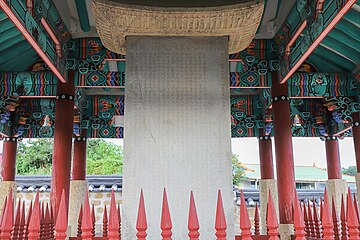해남 명량대첩비
| 해남 명량대첩비 Monument for the Victory at the Battle of Myeongnyang, Haenam |
|
 해남 명량대첩비, 국가유산포털, 국가유산청. |
|
| 대표명칭 | 해남 명량대첩비 |
|---|---|
| 영문명칭 | Monument for the Victory at the Battle of Myeongnyang, Haenam |
| 한자 | 海南 鳴梁大捷碑 |
| 주소 | 전라남도 해남군 문내면 우수영안길 34(동외리 955-6) |
| 지정(등록) 종목 | 보물 |
| 지정(등록)일 | 1969년 6월 16일 |
| 분류 | 기록유산/서각류/금석각류/비 |
| 시대 | 조선 숙종 14년(1688) |
| 수량/면적 | 1기 |
| 웹사이트 | 해남 명량대첩비, 국가유산포털, 국가유산청. |
해설문
국문
해남 명량대첩비는 1597년 9월 16일의 명량대첩을 승리로 이끈 이순신 장군의 공적을 기록한 비이다. 건립연대는 1688년(숙종 14)이다. 1969년 보물로 지정되었다.
비문 앞면 상단에는 ‘통제사충무이공명량대첩비(統制使忠武李公鳴梁大捷碑)’라는 비 이름이 있다. 김만중(金萬重)의 글씨이다. 비문은 21행으로 이루어져 있다. 명량대첩 후 1685년(숙종 11)에 이순신의 공적을 기리고자, 이민서(李敏敍)가 글을 지었다. 비문의 내용은 이민서의 문집 『서하집』, 『이충무공전서』에 수록되어 있다. 비문에는 1597년(선조30) 이순신이 진도 벽파정에 진을 설치하고 우수영과 진도 사이 바다의 빠른 물살을 이용하여 10여척의 배로 왜적함대를 무찌른 상황이 자세히 적혀있다. 비문의 글씨는 이정명(李正英)이 썼다. 비를 세운 것은 1688년(무진년, 숙종14)으로 전라우수사 박신주(朴新胄)가 주도하였고, 감독은 한시달(韓時達)이 하였다.
비는 개석, 비신, 하대석으로 구성되어 있다. 개석은 팔작지붕 형태로 용마루에는 두 마리의 용이 정교하게 조각하였다. 하대석은 직육면체 형태로 연꽃, 연봉오리가 새겨졌다. 명량대첩비는 조선 후기 해남현 고지도에 ‘충무공비각(忠武公碑閣)’으로 표현되어 있다.
비신의 전면 좌·우측과 하단부에 긁힌 흔적이 있다. 1943년 조선총독부는 명량대첩비를 ‘반 시국적 고적’으로 규정하고, 철거하여 경복궁 근정전에 묻었다. 1945년 광복 후 1947년 해남으로 돌아오게 되었다. 그 뒤 해남 지역의 모금 운동으로 문내면 학동리 1187-7에 비각이 건립되었으나, 국도 18호선의 확장 공사로 인해 2011년 원래 위치로 이전하였다.
영문
Monument for the Victory at the Battle of Myeongnyang, Haenam
This stone monument was erected in 1688 to commemorate the military accomplishments of Admiral Yi Sun-sin (1545-1598), who earned Korea a victory in the Battle of Myeongnyang during the Japanese invasions of 1592-1598. In recognition of its historical value, the monument was designated as a Treasure in 1969.
The Battle of Myeongnyang took place on the 16th day of the 9th lunar month in 1597 at Myeongnyang Strait, which separates the Hwawonbando Peninsula in Haenam and Jindo Island. The battle is remembered as an unlikely victory of the Korean navy under the command of Yi Sun-sin, who managed to defeat the Japanese armada of about 100 vessels with only 13 ships by utilizing the strait’s rapid currents. This victory allowed the Korean navy to regain naval dominance.
The monument consists of a pedestal, a body stone with an inscription, and a capstone. The rectangular pedestal is decorated with lotus flower and bud designs, while the capstone is shaped like a hip-and-gable roof with two ornately sculpted dragons atop its main ridge. The monument’s full name is inscribed at the top of the body stone. The main text, which is inscribed in 21 rows, was composed in 1685 by the civil official Yi Min-seo (1633-1688) and includes a detailed description of the battle. The text was calligraphed by the civil official Yi Jeong-myeong (1642-1700).
In 1943, during the Japanese colonial period (1910-1945), the monument was deemed to be “an anti-government artifact” and was therefore dismantled and buried behind Geunjeongjeon Hall in Gyeongbokgung Palace. After Korea regained independence, the monument was returned to Haenam in 1947 and housed in a pavilion built in the neighboring Hakdong-ri Village through the donations of local residents. However, in 2011, the pavilion was moved to its current site in Dongoe-ri Village due to road construction.
영문 해설 내용
이 비석은 임진왜란 때 명량대첩을 승리로 이끈 이순신(1545-1598)의 공적을 기록하여 1688년에 세워졌다. 역사적 가치를 인정받아 1969년 보물로 지정되었다.
명량대첩은 음력 1597년 9월 16일 해남의 화원반도와 진도 사이의 해협에서 일어난 해전이다. 이순신의 수군은 불과 13척의 배만 가지고 있었지만, 해협의 빠른 물살을 이용하여 100여 대가 넘는 왜적 함대를 크게 무찔렀다. 조선군은 이 전쟁에서 승리함으로써 제해권을 되찾았다.
비석은 받침돌, 비문이 새겨진 몸돌, 머릿돌로 이루어져 있다. 받침돌은 직육면체 형태로 연꽃과 연봉오리 문양이 새겨져 있다. 머릿돌은 팔작지붕 형태이고, 용마루에는 두 마리의 용이 정교하게 조각되어 있다. 몸돌 맨 윗부분에는 비 이름이 새겨져 있다. 21행으로 이루어진 비문의 본문은 1685년 문신 이민서(1633-1688)가 지었고, 명량대첩 당시의 상황이 자세히 적혀 있다. 비문의 글씨는 문신 이정명(1642-1700)이 썼다.
일제강점기인 1943년 조선총독부는 명량대첩비를 ‘반 시국적 고적’으로 규정하고, 철거하여 경복궁 근정전에 묻었다. 1945년 광복 후 1947년 해남으로 돌아오게 되었다. 그 뒤 해남 지역의 모금 운동으로 학동리에 비각이 건립되었으나, 국도 확장 공사로 인해 2011년 지금의 위치인 동외리로 옮겼다.